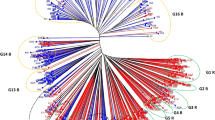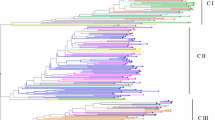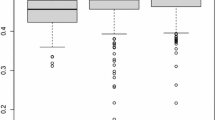Abstract
To break the decades-old yield barrier in pigeonpea [Cajanus cajan (L.) Millsp.] a hybrid breeding technology was successfully developed and the first two hybrids were recently released in India. In order to produce heterotic hybrid combinations, the first logical step is the identification and selection of genetically diverse parents with favorable alleles. In this context, the concept of classifying hybrid parents into different heterotic groups was developed and successfully used in maize and later adopted in other crops. Since hybrid technology in pigeonpea is new, the authors have made the first attempt to identify heterotic groups using SCA effects of 102 crosses generated from line × tester mating and evaluated them at four locations. Based on the performance of hybrids in terms of SCA effects, seven heterotic groups were constituted. Besides this, a scheme to use this information in breeding high yielding hybrids with specific or wide adaptation is also discussed herein. Genetic diversity between lines and tester showed positive association with the heterotic pools generated on the basis of SCA.

Similar content being viewed by others
References
Aguiar CG, Schuster I, Amaral AT Jr, Scapim CA, Viera ESN (2008) Heterotic groups in tropical maize germplasm by test crosses and simple sequence repeat markers. Genet Mol Res 7:1233–1244
Baskaran K, Muthiah AR (2006) Interpretation of hybrid vigour in different cross combinations of pigeonpea [Cajanus cajan (L.) Millsp.]. Res Crop 7:243–248
Byth DE, Wallis ES, Saxena KB (1981) Adaptation and breeding strategies for pigeonpea. In: Proceedings international workshop on pigeonpeas 1:15–19 December 1980. International Crops Research Institute for the Semi-Arid Tropics, Patancheru, pp 450–465
Fan XM, Tan JY, Zhang MS, Li YX, Huang YX, Yang JY, Peng ZB, Li XH (2003) Heterotic grouping for 25 tropical maize inbreds and 4 temperate maize inbreds by SSR markers. Acta Sin 29:835–840
FAO (2012) Online agriculture statistics. http://www.faosat.org
Hallauer AR (1999) Temperate maize and heterosis. In: Coors JG, Pandey S (eds) The genetics and exploitation of heterosis in crops. American Society of Agronomy, Crop Science Society of America, pp 353–361
IIPR (2013) All India coordinated research project on pigeonpea, project coordinator’s report. Indian Institute of Pulses Research, Kanpur 13–15th May, 2013
Jahagirdar JE (2003) Line × tester analysis for combining ability in pigeonpea. Ind J Pulses Res 16:17–19
Jelena S, Snežana MD, Zorica P, Milomir F (2007) Characterization of maize inbred lines based on molecular markers, heterosis and pedigree data. Genetika 39:355–363
Khapre PR, Nerkar YS, Makne VG (1993) Combining ability analysis over cropping systems for grain yield and related characters in pigeonpea. Ind J Genet 53:147–152
Manyasa EO, Silim SN, Githiri SM, Christiansen JL (2008) Diversity in Tanzanian pigeonpea [Cajanus cajan (L.) Millsp.] landraces and their response to environments. Genet Res Crop Evol 55:379–387
Melchinger AE, Gumber RK (1998) Overview of heterosis and heterotic groups in agronomic crops. In: Lamkey KR, Stoub JE (eds) Concepts and breeding of heterosis in crop plants. CSSA Special Publication no. 25. CSSA, Madison, pp 29–44
Narladkar VW, Khapre PR (1996) Heterosis for yield and yield components in pigeonpea. Ind J Pulses Res 4:35–41
Pandey N (1999) Heterosis and combining ability in pigeonpea. Leg Res 22:147–151
Patel GV, Zaveri PP, Pathak AR (1991) Heterosis for morphological attributes in pigeonpea. Ann Agric Res 8:184–186
Phad DS, Madrap IA, Dalvi VA (2009) Heterosis in relation to combining ability effects and phenotypic stability in pigeonpea. J Food Leg 22:59–61
Ramalingam J, Nadarajan N, Vanniyarajan C, Rangasamy P (1997) Combining ability studies involving cms lines in rice. Oryza 34:4–7
Reif JC, Melchinger AE, Xia XC, Warburton ML, Hoishington DA, Vasal SK, Bohn M, Frisch M (2003) Use of SSRs for establishing heterotic groups in sub-tropical maize. Theor Appl Genet 107:947–957
Richey FD (1922) The experimental basis for the present status for corn breeding. J Am Agron 14:1–17
Rohlf FJ (1992) NTSYS-pc (Numerical Taxonomy and Multivariate Analysis System). Version 1.70. Exeter, Setauket
Sameer Kumar CV, Sreelakshmi Ch, Varma P (2009) Studies on combining ability and heterosis in pigeonpea (Cajanus cajan L.). Legume Res 32:92–97
Saxena KB (2006) Seed production systems in pigeonpea. International Crops Research Institute for the Semi-Arid Tropics, Patancheru, 76 pp. ISBN 92-9066-490-8
Saxena KB (2008) Genetic improvement of pigeonpea—a review. Trop Plant Biol 1:159–178
Saxena KB, Kumar RV, Srivastava N, Shiying B (2005) A cytoplasmic-nuclear male-sterility system derived from a cross between Cajanus cajanifolius and Cajanus cajan. Euphytica 145:289–294
Saxena KB, Kumar RV, Tikle AN, Saxena MK, Gautam VS, Rao SK, Khare D, Chauhan YS, Gowda CLL, Sawargaonkar SL (2013a) ICPH2671—the world’s first commercial food legume hybrid. Plant Breed 132(5):479–485
Saxena KB, Kumar RV, Sameer Kumar CV, Saxena RK, Mula M, Pande S, Srivastava RK, Varshney RK, Khare D, Rao SK (2013b) ICPH 2740—a high yielding CMS based pigeonpea hybrid for central and south India. Ind J Genet (submitted, unpublished)
Sharma JR (1988) Statistical and biometrical techniques in plant breeding. New Age International Publishers, New Delhi, pp 17–24. ISBN: 81-224-0888-5
Songok S, Ferguson M, Muigai AW, Silim S (2010) Genetic diversity in pigeonpea [Cajanus cajan (L.) Millsp.] landraces as revealed by simple sequence repeat markers. Afr J Biotechnol 9:3231–3241
Sprague GJ, Tatum LA (1942) General vs. specific combining ability in single crosses of corn. J Am Agron 34:923–932
Srinivas TK, Jain C, Reddy MV (1998) Combining ability studies of sterility mosaic resistant pigeonpea [Cajanus cajan(L.) Millsp.]. Crop Res 15:99–103
Vanniarajan CP, Rangasamy P, Nadrajan N, Ramlingam J (1999) Genotypes grouping based on stability parameters in pigeonpea. J Mah Agric Univ 24:293–294
Venkateswarlu S, Singh RB (1982) Combining ability in pigeonpea. Ind J Genet 42:11–14
Yadav AS, Tank CJ, Acharya S, Patel JB (2008) Combining ability analysis involving Indo-African genotypes of pigeonpea. J Food Leg 21:95–98
Yuan LX, Fu JV, Liu XJ, Peng ZB, Zhang SH, Li XU, Li LC (2000) On significance of heterotic groups theory in hybrid rice breeding. Sci Agric Sin 33:1–9
Acknowledgments
The financial support received from Bill and Melinda Gates Foundation (TL II Project) is acknowledged. Authors acknowledge support of Dr. Vkas Singh for his contribution in improving this manuscript.
Author information
Authors and Affiliations
Corresponding author
Rights and permissions
About this article
Cite this article
Saxena, K.B., Sawargaonkar, S.L. First information on heterotic groups in pigeonpea [Cajanus cajan (L.) Millsp.]. Euphytica 200, 187–196 (2014). https://doi.org/10.1007/s10681-014-1142-0
Received:
Accepted:
Published:
Issue Date:
DOI: https://doi.org/10.1007/s10681-014-1142-0




